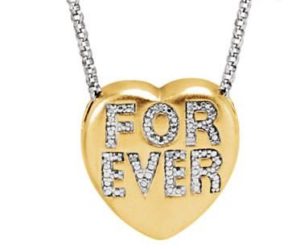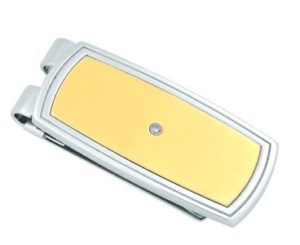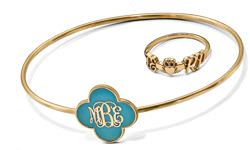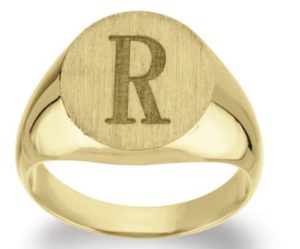Marketing the Niche
Niche marketing is about developing products or services that are directly fulfilling the needs and wants of a specific, narrow group. Marketing experts say that the narrower the niche, the stronger your business will be, as long as you choose a niche that is accurate and reflects an authentic need.
 Identified as the fastest growth market in the jewelry category, men’s jewelry is hailed a great niche for jewelers to pursue. According to the statistic portal Statista, men’s jewelry generated a sales value of $3.3 billion and watches 3.1 billion in the U.S. in 2014, top two men’s accessories. Also a proven bestseller, children’s jewelry offers relationship building and year round sales opportunities for gifters and self-purchasers for a small investment in merchandise and real estate—part of the $11 billion children’s apparel and accessories business.
Identified as the fastest growth market in the jewelry category, men’s jewelry is hailed a great niche for jewelers to pursue. According to the statistic portal Statista, men’s jewelry generated a sales value of $3.3 billion and watches 3.1 billion in the U.S. in 2014, top two men’s accessories. Also a proven bestseller, children’s jewelry offers relationship building and year round sales opportunities for gifters and self-purchasers for a small investment in merchandise and real estate—part of the $11 billion children’s apparel and accessories business.
What’s important for jewelers to remember when carving out these niche markets is to carve out special areas that give them their own identity. This is especially important for men’s jewelry. Jewelry stores are already perceived as being female focused and intimidating to navigate for men.
Man Cave
“Look at your store environment and ask yourself what you can do differently in terms of product mix, vibe in the store and engagement online so that men are not afraid to enter the space,” advises Amanda Gizzi, director of public relations and special events for the Jewelers of America. She advocates men have their own area that speaks to them and their needs and comfort zones.

“Find cool partners like a tie brand you can carry in store to help male clients start thinking about the big picture of fashion and style,” suggests Gizzi. “Get a focus group together to find out what your male customers like and want. Make a section that’s catered to them.” She promotes engaging men on a different level, i.e. host a sports viewing party; if the home team wins, offer 20% off purchase.
Jewelers really need to create a men’s department, promotes Scott Rauch, president of SHR Jewelry Group/S.D.C. Designs, New York. “Men’s watches, accessories and wedding bands should all be in one area. Other fashion and accessory categories get that, but in jewelry stores it leans very much to women and men are an afterthought mixed in. Jewelers need to create a men’s accessory area that speaks to men.” He hails department stores as doing a good job of this, creating a space where men buy their fashions and accessories together. He advises jewelers consider stocking a small variety of other accessories to give male clients options that work together to create a look.
Karen Crowe, Marketing/Merchandising, Quality Gold, Fairfield, Ohio advocates cool tones and masculine displays and props like sports accents that will draw attention. “This will also draw the youth market, especially in mall stores. You have to give them that visual that will bring them past the lease line.”
 Moreover, reaching men online and through social media is vital. To help retailers, IBGoodman for example links them into its digital catalogs to show and sell greater depth of product without stocking a huge inventory. The Newport, Kentucky based men’s jewelry manufacturer also has a great web based and social media campaign for jewelers to tap into that can target customers in their markets. “All of these efforts promote product and direct sales to jewelers in specific geographic areas in a very cost effective way,” tells Jonathan Goodman Cohen, company president.
Moreover, reaching men online and through social media is vital. To help retailers, IBGoodman for example links them into its digital catalogs to show and sell greater depth of product without stocking a huge inventory. The Newport, Kentucky based men’s jewelry manufacturer also has a great web based and social media campaign for jewelers to tap into that can target customers in their markets. “All of these efforts promote product and direct sales to jewelers in specific geographic areas in a very cost effective way,” tells Jonathan Goodman Cohen, company president.
The stores that do best with the men’s category are the ones that have a very clearly defined niche and create a comfortable “fit” for the men’s category within that niche, explains Kate Peterson, president of Performance Concepts, Montgomery Village, Maryland. “For a store that clearly lives in the ultra-contemporary space it makes sense to stock contemporary steel and rubber bracelets alongside fashion gold cufflinks and lapel pins.”
Crowe laments that men’s accessories are promoted big for Father’s Day and Christmas and then treated like loss leaders around other gift giving holidays. “With women shopping for unique items for holiday, birthday and anniversary gift giving, sprucing up and calling attention to your men’s line is a must.”
Peterson concurs, citing the spending power of women as the real wild card in the mix. “Retailers who can make the case for gifting men’s jewelry will capitalize on the new fashion interest. The challenge is that, like men, women buying gifts want to buy something the recipient will like and wear, making it essential that the retailer capture the interest of the fashion-savvy men most likely to gravitate toward their piece of the market.”
Kids Corner

The same philosophies apply to developing a children’s jewelry section. “Pay attention to where the product is placed,” advises Alix Gonsoulin, Director of Fine Jewelry, Stuller, Lafayette, Louisiana. “Jewelers have the opportunity to call this category out in a different, more playful way as per the audience. Add a little something to make it stand out as its own.”
Gizzi advocates the space should be all encompassing, even if it’s a small section of the store. “Make it a fun, inspiring and interactive, encouraging sharing on social media.” In fact, she advises jewelers to be heavy on social media, promoting moms and daughters, sisters and girlfriends for this category.
Jewelers should also remember that the youth jewelry market is not just for gift givers. “I was shocked by a statistic that the average 16 year old walking through a shopping center has $57 cash in pocket,” cites Peterson. “Young people are earning or getting and spending money much earlier than before. Consider that along with the average age of the first time bridal couple at an all time high, it’s clear the engagement ring is no longer the first fine jewelry purchase for most. We’re encouraging our retailers to go after the young fashion market as the first step in building long-term loyalty. If you don’t have them by the time they’re ready for the engagement ring, you’ll likely not have a shot at that sale.”
 But when looking at niche markets, jewelers should keep in mind the big picture. Peterson notes that it’s not so much about finding a perfect category or area, as it is clearly articulating your brand identity and being consistent with everything you do after that, says Peterson. “We work to get our retail clients to look hard at who they are, why they are, and what they want to stand for in their market—then build the staff, product selection and policies and practices to support that vision.”
But when looking at niche markets, jewelers should keep in mind the big picture. Peterson notes that it’s not so much about finding a perfect category or area, as it is clearly articulating your brand identity and being consistent with everything you do after that, says Peterson. “We work to get our retail clients to look hard at who they are, why they are, and what they want to stand for in their market—then build the staff, product selection and policies and practices to support that vision.”










